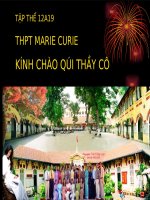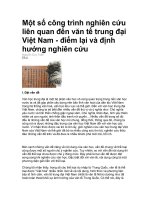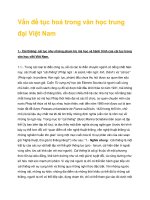Văn hoá áo dài việt nam
Bạn đang xem bản rút gọn của tài liệu. Xem và tải ngay bản đầy đủ của tài liệu tại đây (7.77 MB, 21 trang )
Ao dai’s History
Group 4
Vu Duc Thanh (Leader)
Pham Tran Thanh
Duong Hong Duong
I. Introduce
Ao Dai is an outfit that is innovated from
the five-body dress of Vietnam during the
Westernization period, also known as the
modern Ao Dai. Ao Dai is considered a
Vietnamese woman's costume with two
front and back designs. cover the outside
of the trousers.
Originating from the four-flap shirt in the 17th century, the Vietnamese Ao Dai has undergone
many changes to serve the needs and roles of women in each previous period. gradually took
shape in the 1960s.
II. History
• The original design of the Ao Dai was a
four-flap consignment shirt, the precursor
of the four-body shirt.
• The consignment shirt is worn over the
camisole, wearing the same black skirt and
belt of the same color as the four-piece
shirt, only the two front flaps are loose, not
tied in front of the abdomen.
III. Four part dress - Five part dress
• To make it more convenient for the co-workers and hard-working traders, the
ancients invented a neat four-body dress. As a costume of the common people,
the four-body shirt is often sewn from dark fabric for convenience in work.
• Urban women with little labor often wear a
five-piece dress to distinguish themselves
from the working-poor class. The shirt had a
wide neck and shape, and was widely worn
until the beginning of the 20th century.
The photo shows the class distinction in a family,
with the owner wearing a five-piece dress and
the servants wearing a four-piece dress.
(1884-1885)
IV. Lemur Ao Dai (1939-1943)
• A bold breakthrough, contributing to the
shape of the Ao Dai today is the Ao Dai
"Lemur" created by artist Cat Tuong in 1939.
• The shirt was strongly condemned by public
opinion at that time, considered indecent, so
only modern artists dared to wear it. By
1943, this style of shirt was gradually
forgotten.
V. Ao Dai with Raglan sleeves (1960)
In the 1960s, tailor Dung in Saigon
introduced a way to assemble Raglan's
hands into long dress. This type of
assembly not only minimizes wrinkles,
allows the shirt to fit snugly along the
curve, and helps women move their
hands freely and flexibly. From here,
the Vietnamese long dress was
shaped.
Drawing of long dress with Raglan sleeves
VI. Ao Dai Ba Nhu (early 1960)
• In the early 1960s, Mrs. Tran Le Xuan, the wife of
Mr. Ngo Dinh Nhu, designed an open-collared Ao
Dai, removing the collar, also known as the boat
neck. The famous ao dai called Madame Nhu's Ao
Dai was met with strong reactions because it went
against the fine customs and traditions of the
society at that time.
• Today, boat neck dresses are very popular
because of their comfort, suitable for hot
climates.
Ms. Tran Le Xuan, the initiator of the movement to wear a
boat-neck dress.
In the 1960s, ao dai at the waist
became fashionable. Urban
women with an open mind want
to enhance their body curves
through tight-waisted Ao Dai.
Near the end of the 60s, mini Ao Dai became popular among schoolgirls because of its comfort and
convenience. The hem is narrow and short to the knee, but still sews along the curve of the body.
VII. Ao Dai with tight waist - mini Ao Dai (1960-1970)
VIII. Modern Ao Dai (1970 to present)
After the 1970s, the renewed life made the Ao Dai gradually disappear from the streets.
However, from 2000 up to now, the Ao Dai has been supported with many different designs
and materials through creative and innovative collections of designers.
Not only stopping at the
traditional design, the Ao Dai
has been transformed into a
wedding dress, a short dress to
wear with jeans, etc.
IX. Men's Ao Dai
Men's ao dai is not as popular as women's ao dai. Men's Ao Dai only appears at festivals with
bold Vietnamese traditions or weddings, when launching the family.
X. Uses of Ao Dai
The Ao Dai is the national
costume of Vietnam, exuding
the traditional beauty of the
people and country of
Vietnam.
national dress of Japan or Korea, the Vietnamese Ao Dai has also become an office wear
Ao Dai has always been an endless source of inspiration for painters,
writers and poets.
XI. A symbol of Vietnam
Going through each period, each stage along with the developments of the historical
development process, the Vietnamese Ao Dai still exists with time, is considered a traditional
costume, is a symbol in the culture. of the Vietnamese people.
In the eyes of international friends, that traditional Ao Dai always attracts
admiring eyes.
Thanks for listening









